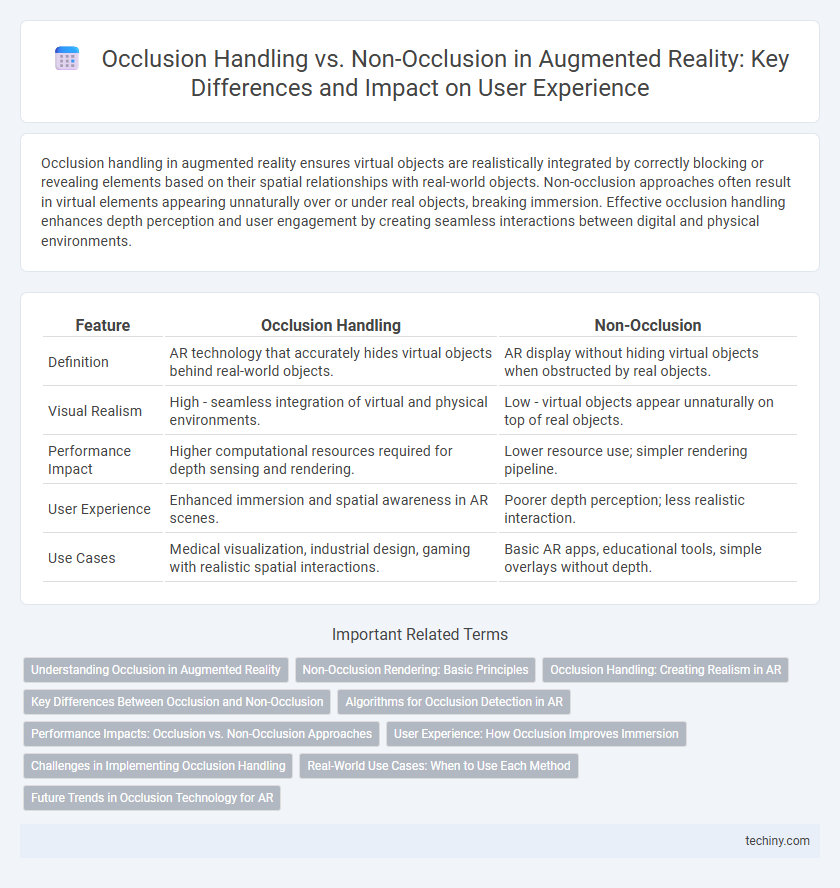Occlusion handling in augmented reality ensures virtual objects are realistically integrated by correctly blocking or revealing elements based on their spatial relationships with real-world objects. Non-occlusion approaches often result in virtual elements appearing unnaturally over or under real objects, breaking immersion. Effective occlusion handling enhances depth perception and user engagement by creating seamless interactions between digital and physical environments.
Table of Comparison
| Feature | Occlusion Handling | Non-Occlusion |
|---|---|---|
| Definition | AR technology that accurately hides virtual objects behind real-world objects. | AR display without hiding virtual objects when obstructed by real objects. |
| Visual Realism | High - seamless integration of virtual and physical environments. | Low - virtual objects appear unnaturally on top of real objects. |
| Performance Impact | Higher computational resources required for depth sensing and rendering. | Lower resource use; simpler rendering pipeline. |
| User Experience | Enhanced immersion and spatial awareness in AR scenes. | Poorer depth perception; less realistic interaction. |
| Use Cases | Medical visualization, industrial design, gaming with realistic spatial interactions. | Basic AR apps, educational tools, simple overlays without depth. |
Understanding Occlusion in Augmented Reality
Occlusion handling in augmented reality ensures virtual objects are realistically blocked by real-world elements, enhancing immersion and spatial coherence. Without occlusion, virtual objects appear unnaturally superimposed, breaking the user's sense of presence. Advanced AR platforms, such as ARKit and ARCore, use depth sensing and environmental mapping to accurately manage occlusion for seamless integration.
Non-Occlusion Rendering: Basic Principles
Non-occlusion rendering in augmented reality bypasses depth-based object obscuration, allowing virtual elements to appear transparently over real-world scenes without considering physical obstruction. This approach simplifies rendering pipelines and reduces computational load by forgoing complex depth and spatial analyses typically required for occlusion handling. As a result, non-occlusion rendering is commonly used in applications prioritizing performance and clarity of virtual overlays over environmental realism.
Occlusion Handling: Creating Realism in AR
Occlusion handling in augmented reality is essential for achieving high levels of realism by accurately simulating how virtual objects are hidden or revealed by real-world elements. Advanced algorithms use depth sensing and spatial mapping to ensure virtual content is correctly layered behind physical objects, enhancing user immersion. Without effective occlusion handling, virtual objects appear unnaturally superimposed, reducing the overall believability of AR experiences.
Key Differences Between Occlusion and Non-Occlusion
Occlusion handling in augmented reality ensures virtual objects are properly hidden or partially obscured by real-world objects, enhancing spatial realism by accurately reflecting depth relationships. Non-occlusion AR displays virtual content without considering real-world object overlap, which can result in visual inconsistencies and reduced immersion. The key difference lies in occlusion's ability to blend virtual elements seamlessly into the physical environment versus non-occlusion's simpler, less realistic overlay approach.
Algorithms for Occlusion Detection in AR
Occlusion handling in augmented reality relies on algorithms such as depth sensing, mesh reconstruction, and image segmentation to accurately detect and render virtual objects behind real-world elements. Advanced machine learning models enhance occlusion detection by analyzing spatial data and improving the alignment of virtual content with physical environments. Non-occlusion approaches bypass these computations, often resulting in virtual objects improperly overlapping real-world surfaces, reducing the immersive experience.
Performance Impacts: Occlusion vs. Non-Occlusion Approaches
Occlusion handling in augmented reality significantly impacts performance due to the increased computational demands of accurately rendering object interactions and depth perception, requiring advanced algorithms and real-time processing capabilities. Non-occlusion approaches, while less resource-intensive, often result in less immersive experiences as virtual objects fail to convincingly integrate with the physical environment. Optimizing occlusion techniques can balance visual realism with performance constraints, leveraging hardware acceleration and efficient depth mapping to maintain smooth frame rates.
User Experience: How Occlusion Improves Immersion
Occlusion handling in augmented reality significantly enhances user experience by enabling virtual objects to realistically interact with real-world environments, creating a seamless blend that strengthens immersion. Proper occlusion ensures virtual elements are correctly hidden or revealed relative to physical objects, preventing visual conflicts that break the sense of presence. In contrast, non-occlusion AR often results in virtual objects appearing unnaturally superimposed, reducing realism and user engagement.
Challenges in Implementing Occlusion Handling
Implementing occlusion handling in augmented reality requires accurate depth sensing and real-time environment mapping, which demand sophisticated hardware and computational resources. Challenges include effectively distinguishing foreground objects from background scenes to ensure virtual content realistically interacts with physical elements, preventing visual artifacts like ghosting or incorrect layering. Limited sensor accuracy, dynamic lighting conditions, and computational latency further complicate the integration of seamless occlusion effects in AR applications.
Real-World Use Cases: When to Use Each Method
Occlusion handling in augmented reality improves realism by accurately rendering virtual objects behind real-world elements, essential for applications like interior design visualization and medical training where spatial relationships are critical. Non-occlusion methods suit simpler AR experiences such as advertising and basic gaming, where performance is prioritized over depth accuracy. Choosing between occlusion handling and non-occlusion depends on the need for immersive interaction versus computational efficiency in specific real-world use cases.
Future Trends in Occlusion Technology for AR
Future trends in occlusion technology for augmented reality emphasize improved depth sensing and AI-driven object recognition to achieve more accurate and realistic integration of virtual objects within real-world environments. Advances in hardware, such as LiDAR-equipped devices and time-of-flight sensors, enable precise mapping of physical spaces, enhancing occlusion handling by allowing virtual elements to be correctly hidden or revealed behind real objects. Machine learning algorithms continue to evolve, facilitating dynamic and context-aware occlusion that adapts in real-time, pushing AR experiences toward higher immersion and interactivity compared to non-occlusion methods.
Occlusion Handling vs Non-occlusion Infographic

 techiny.com
techiny.com